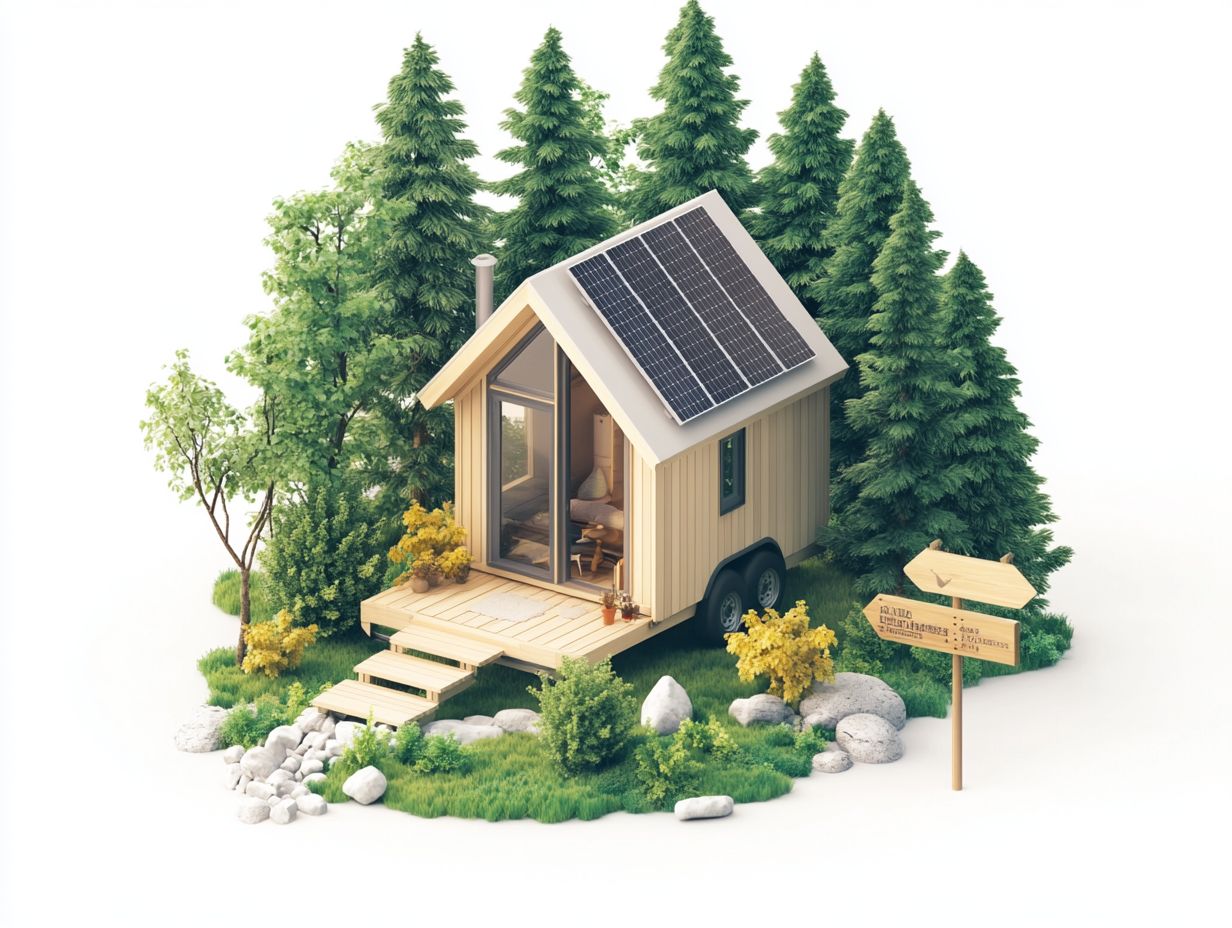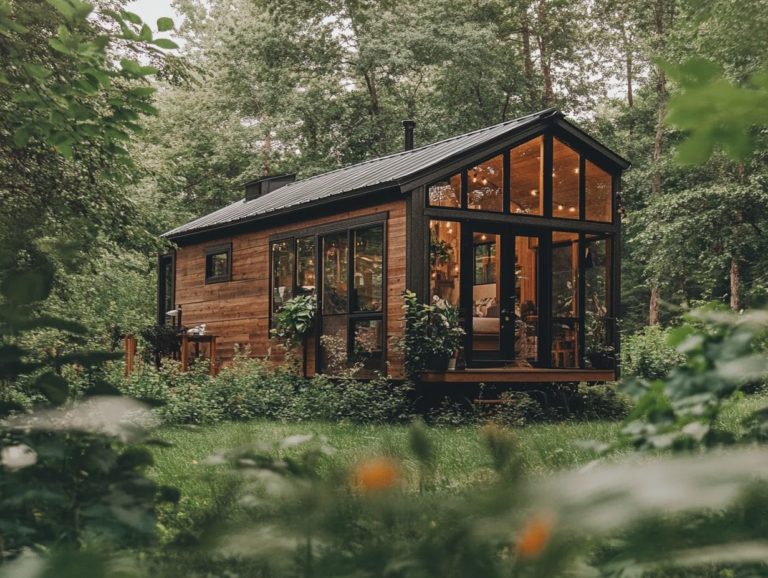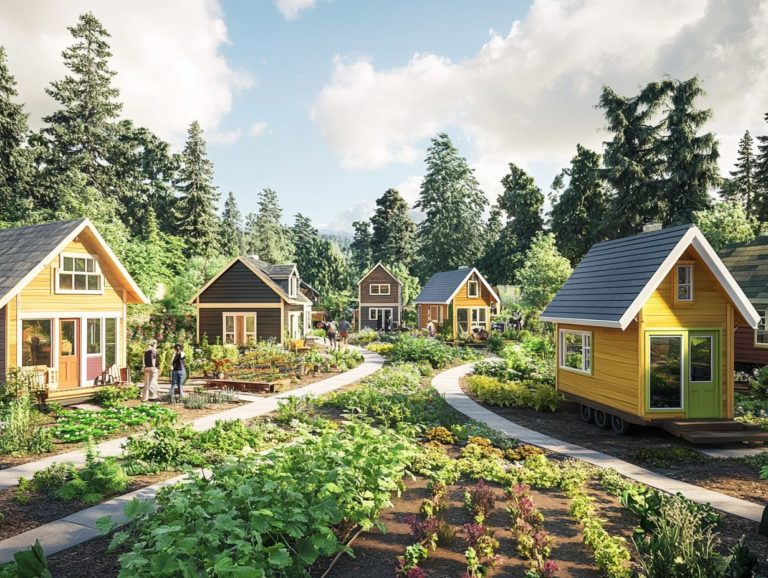Legal Framework for Tiny House Enthusiasts
Tiny houses have seen a remarkable rise in popularity. They attract minimalists, eco-conscious individuals, and those seeking affordable housing solutions.
But what precisely qualifies as a tiny house, and what hurdles might you face when understanding the laws that apply to tiny house regulations?
This article delves into the defining characteristics of tiny houses and examines the zoning and building codes currently influencing them. Zoning refers to laws that determine how land can be used, while building codes are regulations that ensure structures are safe.
You ll discover the challenges tiny house owners confront and learn about the grassroots movements rallying for their legalization within tiny house communities.
Dive into the exciting world of tiny home living with us and the legal frameworks that define it!
Contents
- Key Takeaways:
- The Rise of Tiny Houses
- What is a Tiny House?
- Current Legal Landscape for Tiny Houses
- Navigating Legal Issues for Tiny Houses
- Advocating for Tiny House Legalization
- Frequently Asked Questions
- What is the legal definition of a tiny house?
- Do I need a building permit to build a tiny house?
- Can I park my tiny house anywhere?
- Do I need to have a specific type of insurance for my tiny house?
- What are some common zoning restrictions for tiny houses?
- Are there any legal challenges facing tiny house enthusiasts?
Key Takeaways:

- Tiny houses have been gaining popularity as a lifestyle choice but face legal challenges due to zoning and building codes.
- It’s essential to understand and comply with zoning and building codes to avoid legal issues and potential fines.
- Organizations and movements advocate for the legalization of tiny houses, providing hope for a more accommodating legal framework in the future.
The Rise of Tiny Houses
The rise of tiny houses has transformed into a noteworthy cultural phenomenon both in the United States and beyond. This tiny house movement encapsulates a burgeoning desire for minimalism and sustainable living, shaping the landscape of tiny houses in various states.
These compact dwellings offer a compelling alternative to the traditional housing market. They embody a lifestyle that emphasizes freedom, affordability, and community.
As you explore the allure of tiny house communities, the advantages of these minimalist homes become strikingly evident. They highlight the ability to cater to the demands of contemporary homeowners while resonating with environmental values, particularly in tiny house friendly states.
Exploring the Popularity of Tiny Houses
The popularity of tiny houses has surged in recent years, driven by a mix of economic, environmental, and personal factors that resonate with you as a homeowner.
As you face rising housing costs and stagnant wages, the allure of tiny homes becomes undeniable. This trend speaks to a deeper yearning to downsize, allowing you to shed the burdens of excess belongings and embrace a minimalist lifestyle.
With growing awareness surrounding environmental sustainability, you may find yourself seeking eco-friendly alternatives. Tiny homes, often crafted by innovative tiny house builders focused on sustainable construction techniques, perfectly align with this vision.
As you explore the tiny house movement, you ll discover the joy of community living! Enjoy a reduced environmental footprint and a simplicity that enriches your everyday life!
What is a Tiny House?
A tiny house is generally regarded as a compact, efficient dwelling, typically spanning between 100 to 400 square feet. These can be found in various designs, including tiny houses on wheels and those on foundations.
It s designed to maximize space and functionality while minimizing environmental impact. This concept has evolved from traditional homes to encompass various forms, including tiny houses on wheels and those anchored on foundations, which have become popular choices for tiny house living.
Embracing simplicity and creativity in tiny home living positions you within the vibrant tiny house movement, fostering unique communities that flourish across the globe.
Defining the Concept and Characteristics

The defining characteristics of tiny houses include their small footprint and creative designs. They emphasize sustainable living, which aligns perfectly with the principles of the tiny house movement and minimalist living.
These homes typically span under 400 square feet. This makes every inch count through smart layouts that maximize functionality.
By utilizing eco-friendly materials like reclaimed wood and energy-efficient appliances, you lessen your environmental impact and foster a healthier indoor atmosphere.
Unique designs often highlight multifaceted furniture think beds that fold away and tables that extend allowing you to adapt your space effortlessly. Many choose tiny home living to minimize clutter and embrace a simpler lifestyle.
This choice paves the way for financial freedom and a deeper connection to nature.
Current Legal Landscape for Tiny Houses
The current legal landscape surrounding tiny houses is intricate and varies greatly by region. This creates a patchwork of regulations, zoning laws, and codes that can either support or obstruct your journey into tiny home living.
In certain areas, tiny houses are celebrated as innovative answers to the pressing issue of affordable housing shortages. However, in others, strict regulations can present formidable challenges for those who wish to establish their homes legally.
It’s crucial to understand local laws to avoid setbacks on your tiny house journey! Grasping the nuances of tiny house laws and pinpointing tiny house-friendly states is essential for anyone aspiring to build or own a tiny home.
This ensures compliance with local tiny house regulations.
Overview of Zoning and Building Codes
Zoning and building codes are crucial in determining the legality and feasibility of tiny house projects. Many areas grapple with adapting existing regulations to accommodate these unique dwellings.
These regulations often emerge from frameworks like the International Building Code (IBC) and the International Residential Code (IRC) (rules that help ensure buildings are safe). These codes were primarily crafted with traditional homes in mind, making it challenging for tiny houses to fit within their parameters.
You must navigate a complex landscape of local ordinances that can dictate everything from minimum square footage to the type of foundation required. This impacts not only the construction process but also where you can actually site your home.
Understanding how these codes influence the design and placement of tiny homes is essential if you’re serious about embracing this minimalistic lifestyle in accordance with the latest tiny house construction practices. For a deeper understanding, refer to tiny house regulations, as it often requires advocacy and local adjustments to ensure compliance and gain community acceptance.
Challenges Faced by Tiny House Owners
As a tiny house owner, you may face a myriad of challenges associated with tiny house laws and regulations. These can fluctuate significantly between tiny house-friendly states and those with stricter zoning restrictions.
Navigating these legal obstacles can feel overwhelming. Many municipalities provide little to no clear guidelines for tiny homes, leaving tiny house owners in a challenging position.
This lack of clarity can leave you uncertain about where to legally position your home, potentially exposing you to fines or forced relocations.
On the financial front, securing funding for a tiny house can be tricky. Traditional lenders might be reluctant, perceiving these compact dwellings as high-risk investments compared to conventional homes.
Societal perceptions can add another layer of complexity to your journey. Many people view tiny living with skepticism, questioning the sustainability and seriousness of this lifestyle choice.
These interconnected challenges create a tangled web that tiny home enthusiasts must learn to navigate with finesse.
Navigating Legal Issues for Tiny Houses

Navigating the legal landscape of tiny houses demands a keen understanding of various regulations, including zoning laws and construction codes. By ensuring compliance with these guidelines, you can sidestep potential pitfalls and make the most of your tiny house journey.
Steps to Take for Legal Compliance
To ensure your tiny house complies with legal requirements, follow these essential steps. Start by obtaining the necessary permits and undergoing required inspections, especially in tiny house friendly states.
Begin by thoroughly researching local land use rules, including those specific to tiny house zoning. These rules can greatly influence where and how your tiny house can be situated. Pay attention to specific size restrictions and land use regulations. It’s also important to determine if your tiny house qualifies as a mobile home or a permanent residence.
Once you understand the regulations, talk to local building officials to clear up any questions. Document all communications and keep meticulous records of the permits you obtain. This ensures adherence to tiny home regulations.
Taking this proactive approach will help you avoid potential fines. It will also streamline the process of placing your tiny house on the property you desire.
Advocating for Tiny House Legalization
Start advocating today to change local laws and open doors for tiny houses! Engage actively with local communities, policymakers, and organizations that support the tiny house movement.
Your goal is to create more welcoming environments for tiny homes. Work towards dismantling the legal barriers that currently exist, thereby supporting the tiny house movement.
Organizations and Movements for Change
Many organizations and movements are diligently working to reshape the tiny house landscape. They advocate for policies that promote tiny house living, support tiny house-friendly states, and encourage extra housing units across the nation.
Among these, the Tiny House Association stands out. They offer invaluable resources, educational materials, and networking opportunities for tiny house enthusiasts. For those looking for more information, exploring tiny house legal resources you should know can be incredibly beneficial. Their mission emphasizes sustainable living practices and encourages community engagement.
The American Tiny House Association tirelessly advocates for regulatory reforms. They push for zoning changes that permit tiny houses in both urban and rural areas. Additionally, the Tiny Home Industry Association raises awareness through events and collaborations. They inspire local governments to craft inclusive housing policies and understand tiny house zoning laws.
Together, these movements enhance visibility and actively pave the way for more accessible and affordable housing solutions across the country.
Frequently Asked Questions

What is the legal definition of a tiny house?
The legal definition of a tiny house varies by jurisdiction. Generally, it is a residential structure that is 400 square feet or less in size. These definitions often distinguish between tiny houses on wheels and tiny houses on foundations.
Do I need a building permit to build a tiny house?
Yes, in most cases, you will need a building permit to construct a tiny house. This is because it is considered a permanent structure and must comply with local building codes and regulations.
Can I park my tiny house anywhere?
No, you cannot park your tiny house just anywhere. You will need to find a location that allows tiny houses, such as a designated tiny house community or a property zoned for tiny houses.
Do I need to have a specific type of insurance for my tiny house?
It is recommended to have insurance for your tiny house, just like any other residential structure. You may need a specialized insurance policy that covers tiny houses, as not all traditional homeowners insurance policies will include them.
What are some common zoning restrictions for tiny houses?
Common zoning restrictions for tiny houses include minimum square footage, lot sizes, and limits on permanent structures. Researching local building rules is essential before choosing where to live.
Are there any legal challenges facing tiny house enthusiasts?
Tiny house enthusiasts often face legal challenges. These include getting building permits, finding places to park, and understanding local building rules.
Stay informed and consult legal experts when necessary.






